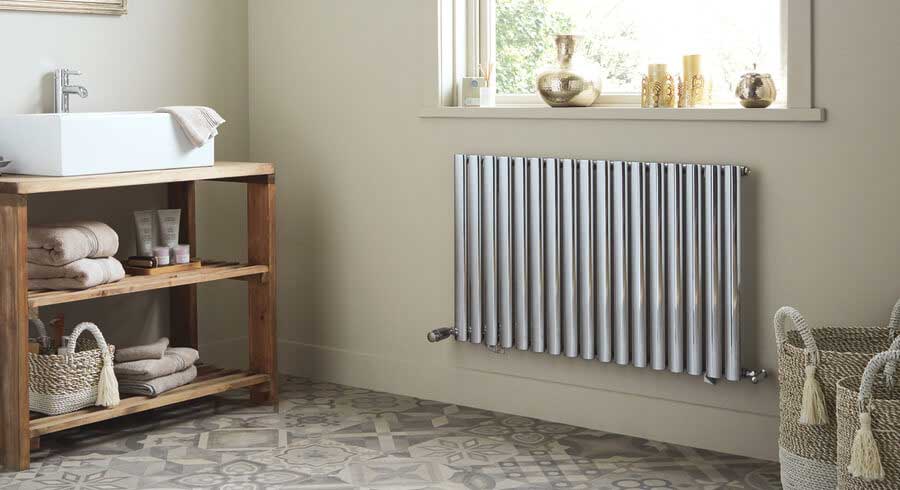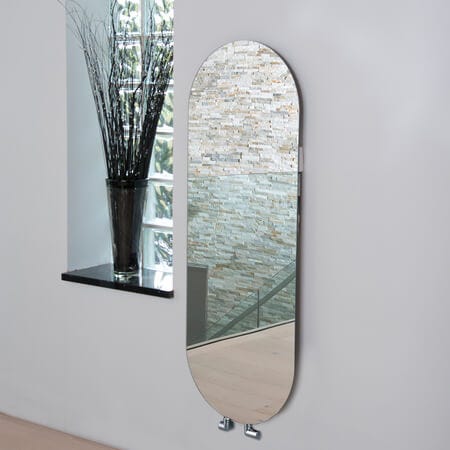The Ultimate Radiator Buying Guide


When it comes to heating your home, you want to be sure you’re making a solid investment. Getting the right type of radiator means you can potentially save on energy bills, heat your home more quickly and even add a decorative touch to your home. You don’t just have to buy a standard white panel – we’ve got plenty of modern designs to choose from here at Robert Dyas.
But before your make your decision, there are several things you need to think about. In this guide we’ll detail everything you need to know about BTU requirements, types of radiators, the different ways of powering them, and what type of valves you might need based on what you currently have in your home.
What is a BTU and how much do I need for my room type?
A BTU (or British Thermal Unit) is simply a measure of heat energy, where 1 watt equals 3.41 BTUs. Every room in your home has a different BTU requirement in order to keep it warm, and it depends on several factors. For example, a large living room with several single glazed windows will require more BTUs to heat than a small cloakroom with no windows.
To work out how many BTUs your radiator should have, you’ll need to use a BTU calculator. Once you’ve calculated the BTU requirement for your room you’ll know which radiators will be suitable. For example, if the BTU requirement for a room was 3,500, you could buy a radiator that gives out around 3,500 BTUs, or buy several radiators to make a total of 3,500 (perhaps 1 x 1,500BTU radiator and 1 x 2,000BTU radiators).
Things to consider
The room type is what determines the style of radiator or towel rail that will be installed. For living rooms, hallways, kitchens etc., you’ll need a typical radiator, whereas for a bathroom or en-suite a towel rail is most typical.
Consider the colour and style of the room – is it a traditional, modern, or contemporary space? There are radiators to suit all room types, in various colours and finishes. They don’t have to be plain white, and towel rails don’t have to be chrome!
If you’re opting for a radiator, think about whether you want it to be horizontal or vertical. Check out the pros and cons of each in the next section.
Don’t forget to take into account the size and BTU output of the radiator – there’s no point having a stunning radiator that suits the room well but doesn’t fit in the space available on the wall, or has a BTU output that’s too low to heat the room comfortably.
If you’re simply updating a radiator that’s already installed in your home, consider the pipe centres of the new radiator (the distance between the two inlets where water enters and exits the radiator). If you match the pipe centres of the current radiator with the new radiator then you can simply swap them over without any need to redirect copper piping, which could save you money on expensive plumbing bills.
What are the different types of radiator?
All radiators are either central heating, electric, or dual fuel, which we’ll explain below. You can also find horizontal radiators as well as vertical, and single and double panel models.
Single or double panel radiators
Single panels make up your regular radiator, which is basically one slim panel fitted closely to the wall.
Double panel radiators are made of two single panels with a gap in the middle, giving them more heating power.
Horizontal or vertical
Benefits of horizontal radiators
- Quicker and cheaper to install if your new radiator is the same size as your existing one, and does not require a plumber to change the pipework
- Possible to update yourself if you’re a keen DIYer
- More choice as there are more horizontal styles on the market, though you can still go for a unique and modern design
Towel rails
Heated towel rails come in various styles and sizes, each with their own unique advantages.
Ladder towel rail
The most popular towel rails are ladder radiators which allow you to hang multiple towels, and can either have a flat or slightly curved profile. Flat towel rails are ideal for smaller spaces, whereas curved ones are better suited to larger bathrooms and provide extra space to hang more towels. The bars themselves can be flat and rectangular or curved tubes.
Designer Towel Warmer
If you’re after something more eye-catching, there are several other designs to choose from, such as this Vetro Star Electric Glass Radiator.
TIP: Cleaning towel warmers it can be a little tricky if the gaps between the rails are small, so use a specially designed radiator brush. This washable microfibre design from Home Valet is long, slim and flexible without being flimsy, making cleaning effortless.
Central heating radiators
Central heating radiators are the most common type, however redirecting pipework to allow for water to get into and out of the radiator can sometimes be tricky or expensive. Therefore, when pipework access is limited it can be easier to opt for a fully electric radiator or towel rail. It simply needs fitting onto the wall and connecting to the mains electricity.
Electric radiators
Electric radiators are usually filled with water or heat-conducting oil, and have an electric heating element installed into the inlet. An electric element is simply a long metal rod that goes into the radiator and heats up the fluid inside (see below). With electric towel rails or radiators you have the option of choosing a thermostatic version, so that you can control the temperature of it via the heating element. Some even allow you to set schedules and timings, and others have smart Bluetooth thermostats.
Dual fuel radiators
Dual fuel is the combination of both electric and central heating. A T-piece is added to the inlet of the radiator, which allows for water to flow into the radiator but also allows for the installation of an electric element (see below). Dual fuel is a great option for bathrooms as you can heat the towel rail independently from the rest of the house. You can have a quick burst of heat to dry towels or get the room toasty warm for your morning shower, all without having to turn on the central heating system. So despite electricity being slightly more expensive than gas, it’s an energy efficient solution as you can selectively heat just one radiator without having to heat your entire home. All of our Towel Rads heating elements come with an additional T-piece so you can decide if you want to go fully electric or dual fuel.
Converting to electric or dual fuel from central heating
If you don’t have easy access to central heating pipework but have found the perfect size and style, or want specific radiators to come on independently, you may want to consider converting your energy supply. To convert a towel rail or radiator into an electric or dual fuel-type setup, you simply need to buy an electric heating element. You can fit one of these into most towel rails. The same is true for radiators, however it does depend on whether the shape of the radiator allows for the element to be inserted into it. Curvy designs won’t allow the heating element to fit.
Types of heating elements
We offer a variety of heating elements, from those with fixed temperatures through to smart control elements. When choosing an element, it’s important to consider the wattage of the radiator that it’ll be paired with, so bear this in mind when buying. To help you make the right decision, we’ve laid out the differences between each type below.
Fixed temperature element
- Entry level
- Fixed at 65°C
- Controlled from a wall switch
Thermostatic element
- Multiple heat settings
- Displays the temperature at which it’s currently set
Low surface temperature (LST) element
- Pre-programmed to run at 43°C
- Designed for environments where there are safety concerns, e.g. in households with disabled children or elderly people
- Surface is at a lower temperature without reducing the heat performance, so it can be touched without causing harm
Smart element
- Bluetooth/smartphone-controlled
- Multiple heat settings
- Full 7-day timer functionality
- Controlled via apps
What’s the best material for a radiator?
The most common types of metal for radiators are steel and aluminium.
Steel is incredibly durable and 100% recyclable, and the stainless steel variety has excellent anti-corrosive properties. Stainless steel also stays warm for a long time after you turn off the heating.
Aluminium heats up 3-4 times faster, making it extremely energy efficient. Like steel models, aluminium radiators are also easily recycled, yet they’re much more lightweight than their steel counterparts, which makes them easier to install.
Valves
Any radiator or towel rail that is going to be plumbed into the central heating system will require valves. The type of valve you buy will depend on three main factors:
- Where the pipework comes from and where it goes into the radiator
- The style of valve (to suit the radiator)
- Whether it’s thermostatic or manual
If you’re planning on having a dual fuel setup, you’ll still require valves as you’ll be connecting the radiator to the central heating system. It would look something like this:


If your pipes come from the floor you’ll require one angled and one straight valve. One goes into the T-piece at an angle, and the other goes straight into the towel rail inlet.


If your pipes come from the wall you’ll require two angled valves.
Which radiator valves do I need?


Side connections
The valves are situated at either side of the radiator close to the bottom.


Underside connections
The valves are underneath the radiator at either end or in the middle.
Use our easy-to-follow guide below to work out which type you need.
Side connections with pipes coming up from the floor
You need angled valves.
Underside connections with pipes coming up from the floor
You need straight valves.
Side connections with pipes coming out of the wall
Choose either angled or corner valves. Angled valves are more traditional, whereas corner valves look a little neater as the tops of them sit cleanly upright instead of facing out into the room.
Underside connections with pipes coming out of the wall
Choose either angled or corner valves, as above.
















